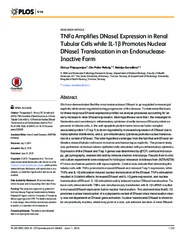| dc.contributor.author | Thiyagarajan, Dhivya | |
| dc.contributor.author | Rekvig, Ole Petter | |
| dc.contributor.author | Seredkina, Natalya | |
| dc.date.accessioned | 2016-03-03T12:38:37Z | |
| dc.date.available | 2016-03-03T12:38:37Z | |
| dc.date.issued | 2015-06-11 | |
| dc.description.abstract | We have demonstrated that the renal endonuclease DNaseI is up-regulated in mesangial
nephritis while down-regulated during progression of the disease. To determine the basis
for these reciprocal DNaseI expression profiles we analyse processes accounting for an
early increase in renal DNaseI expression. Main hypotheses were that i. the mesangial inflammation
and secreted pro-inflammatory cytokines directly increase DNaseI protein expression
in tubular cells, ii. the anti-apoptotic protein tumor necrosis factor receptorassociated
protein 1 (Trap 1) is down-regulated by increased expression of DNaseI due to
transcriptional interference, and iii. pro-inflammatory cytokines promote nuclear translocation
of a variant of DNaseI. The latter hypothesis emerges from the fact that anti-DNaseI antibodies
stained tubular cell nuclei in murine and human lupus nephritis. The present study
was performed on human tubular epithelial cells stimulated with pro-inflammatory cytokines.
Expression of the DNaseI and Trap 1 genes was determined by qPCR, confocal microscopy,
gel zymography, western blot and by immune electron microscopy. Results from in vitro
cell culture experiments were analysed for biological relevance in kidneys from (NZBxNZW)
F1 mice and human patients with lupus nephritis. Central data indicate that stimulating the
tubular cells with TNFα promoted increased DNaseI and reduced Trap 1 expression, while
TNFα and IL-1β stimulation induced nuclear translocation of the DNaseI. TNFα-stimulation
resulted in 3 distinct effects; increased DNaseI and IL-1β gene expression, and nuclear
translocation of DNaseI. IL-1β-stimulation solely induced nuclear DNaseI translocation. Tubular
cells stimulated with TNFα and simultaneously transfected with IL-1β siRNA resulted
in increased DNaseI expression but no nuclear translocation. This demonstrates that IL-1β
promotes nuclear translocation of a cytoplasmic variant of DNaseI since translocation clearly
was not dependent on DNaseI gene activation. Nuclear translocated DNaseI is shown to
be enzymatically inactive, which may point at a new, yet unknown function of renal DNaseI. | en_US |
| dc.identifier.citation | PLoS ONE 2015, 10:e0129485(6) | en_US |
| dc.identifier.cristinID | FRIDAID 1279368 | |
| dc.identifier.doi | 10.1371/journal.pone.0129485 | |
| dc.identifier.issn | 1932-6203 | |
| dc.identifier.uri | https://hdl.handle.net/10037/8645 | |
| dc.identifier.urn | URN:NBN:no-uit_munin_8242 | |
| dc.language.iso | eng | en_US |
| dc.publisher | Public Library of Science | en_US |
| dc.rights.accessRights | openAccess | |
| dc.subject | VDP::Medisinske Fag: 700::Basale medisinske, odontologiske og veterinærmedisinske fag: 710::Medisinsk molekylærbiologi: 711 | en_US |
| dc.subject | VDP::Medical disciplines: 700::Basic medical, dental and veterinary science disciplines: 710::Medical molecular biology: 711 | en_US |
| dc.title | TNFα amplifies DNaseI expression in renal tubular cells while IL-1β promotes nuclear DNaseI translocation in an endonuclease-inactive form | en_US |
| dc.type | Journal article | en_US |
| dc.type | Tidsskriftartikkel | en_US |
| dc.type | Peer reviewed | en_US |


 English
English norsk
norsk